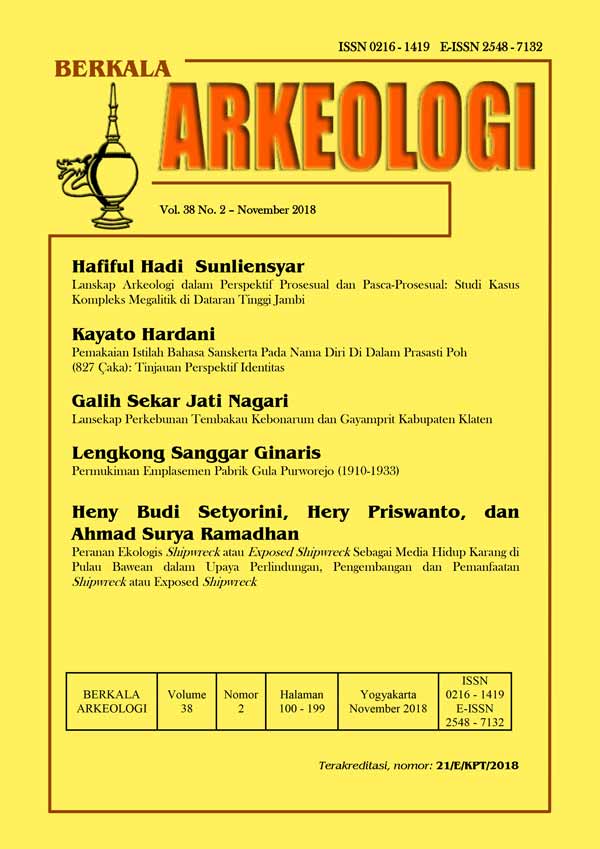PEMAKAIAN ISTILAH BAHASA SANSKERTA PADA NAMA DIRI DI DALAM PRASASTI POH (827 SAKA): TINJAUAN PERSPEKTIF IDENTITAS
Main Article Content
Abstract
Proper names in general use as the individual differentiator within the community as well as the identity. Parent in giving name on their newly born baby is often based on some motivation. Proper names can be analyzed linguistically because it contains elements of the sign that serves referential as well as vocative. The proper names is a part of the human being itself, so that in every interaction within society, someone always conscious of his own identity for his own interests, the other person and society as his place of life and interaction. Diachronically the development of language, including the use of the name itself can be traced back its presence through written inscriptions in the form of inscriptions. The writing of the proper name in Poh inscription is explicitly only as a list of attendees (witnesses) who attended the inauguration ceremony. Starting from this point can be found the use of the name of the old Javanese period. This study aims to understand the construction and meaning in the proper name found in the Poh Inscription using an identity perspective. The method used in this study is descriptive qualitative which begins with observing and analyzing proper names using Sanskrit language elements.
Article Details

This work is licensed under a Creative Commons Attribution-NonCommercial-ShareAlike 4.0 International License.
References
Christie, J W. 1989a. “Raja dan Rama : Negara Klasik di Jawa Masa Awalâ€, dalam Lorraine Gesick ( ed.). Pusat, Simbol dan Hirarki Kekuasaan, Jakarta: Yayasan Obor Indonesia.
---------------. 1989b. “Wanua, Thani, Paraduwan: The Disintegrating Village in Early Javaâ€. Dalam Wolfgang Marschall (ed). Proceeding of the 7th European Colloqium on Indonesian and Malay Studies. Bern : Institut für Ethnologie.
De Casparis, J.G. 1986. “Some Aspects of Proper Names in Ancient Javaâ€, dalam CD. Grijns and S.O.Robson (eds), Cultural Contact And Textual Interpretation: Papers From The Fourth European Colloquium On Malay And Indonesian Studies, Held In Leiden In 1983, hlm. 8-18. Dordrecht/Cinnaminson: Foris. KITLV, Verhandelingen 115.
Kosasih, D. 2010. Kosmologi Sistem Nama Diri (Antroponim) Masyarakat Sunda: dalam Konstelasi Perubahan Struktur Sosial Budaya, Makalah disajikan dalam Seminar Internasional â€Hari Bahasa Ibu†dengan tema: â€Menyelamatkan Bahasa Ibu sebagai Kekayaan Budaya Nasional†di Gedung Merdeka tanggal 19-20 Februari 2010.
MacDonnel, Ar A. 1893. Sanskrit-English Dictionary, New York : Longmans Green and Co.
Magli, G. 2009. Mysteries and Discoveries of Archaeoastronomy From Giza to Easter Island, New York: Copercinus Books.
Mahsun. 2010. Genolinguistik: Kolaborasi Linguistik Dengan Genetika Dalam Pengelompokan Bahasa dan Populasi Penuturnya. Yogyakarta : Pustaka Pelajar.
Meskell, L. 2007. A Companion to Social Archaeology, New Jersey : Blackwell Publishing Ltd.
Rahardjo, S. 2011. Peradaban Jawa Dari Mataram Kuno Sampai Majapahit Akhir, Jakarta: Komunitas Bambu.
Schimmel, A. 1989. Islamic Names, Edinburg : Edinburg University Press.
Sedyawati, E. 1986. “ Kajian Kuantitatif Atas Masalah Local Genius â€. Dalam Pertemuan Ilmiah Arkeologi IV 3-9 Maret , Cipanas.
Stets, J E. &Richard S. 2016. New Directions in Identity Theory and Research. New York : Oxford University Press.
Stutterheim, W. F. 1940. “Oorkonde van Balitung Uit 905 A.D (Randoesari I)â€, dalam INI 1. hal. 4 – 7.
Tjahjono, B D & Rangkuti, N. 1998. “Penetapan SÄ«ma Dalam Konteks Perluasan Wilayah Pada Masa Klasik : Kajian Berdasar Prasasti-Prasasti Balitung (899-910 M) â€. Berkala Arkeologi, Tahun XVIII.
Widodo, S T. 2001. “Nama Diri Masyarakat Jawaâ€. Disertasi. Universitas Sebelas Maret. Surakarta.
Zabeeh, F. 1968. What Is In A Name: An Inquiry into The Semantics and Pragmatics of Proper Name. The Hague: Martinus Nijhoff.

